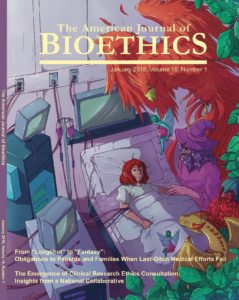by Eric S. Swirsky, JD, MA
It is my privilege to introduce the health humanities community to the work of biomedical visualization students at the University of Illinois at Chicago, whose work will be featured as cover art in forthcoming issues of AJOB. These students receive interdisciplinary training to become highly skilled medical and scientific illustrators, medical animators, educators, and Web and media specialists. Operating in areas of semiotics, these professionals help to convey meaning to providers, patients, and other stakeholders with deliberate use of language and symbol. Working with AJOB editorial leadership, concepts from accepted journal articles are pitched to student artists in a studio-style format where the ethical issues are extruded and explained, artistic muses are considered, and completed works are openly critiqued for revision. This process has resulted in artwork accepted by AJOB editors for journal covers and AJOB blog posts from the artists describing their creative inspiration and process, beginning with issue 18(1) and the work of Elizabeth Moss. It is in this vein that these students’ artwork can contribute to AJOB and the health humanities community at large—providing visual representation of the issues that ethicists and others in the health humanities work through, and conveying meaning in new and accessible ways across disciplines and walks of life. It is our hope that the AJOB community of authors and readers will benefit in these and other unforeseen ways.
Artist’s Blurb
by Elizabeth Moss, BFA
When conceptualizing this piece and sketching out designs, the most interesting ideas spawned from thinking about dreams and fantasies. The topic of fantasy cures, especially in the area of pediatrics, can be a difficult subject to discuss with various factors to consider. These thoughts needed to be addressed in the final image in order to show how this can be a complicated and emotional topic. One side of the image illustrates the hopes of these cures, the fantastical dreams that they will work out perfectly and be the magic bullet of a solution. The other side shows the reality, which is a lot of treatment, effort, and suffering for something that has a slim chance of succeeding. The overall image is meant to draw the viewer into this fantasy world and then direct their attention to the darker underlying message. It’s not meant to be a hopeless image, but more of a reminder to always keep an eye on the reality of what these cures actually mean for the patient.